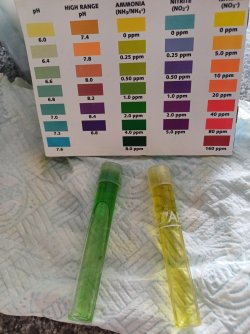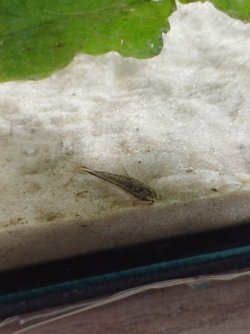Not adding anything that raises the pH, although when I test it's usually about 7.4ish, will test tomorrow morning. No nitrite showing up when I test either.I think you said you are using straight RO? That means your pH will be 7.0 or very close which means the ammonia will be quite a bit less toxic than say pH 7.5 or so which you might get in your area of UK without RO? Unless you are adding anything to the RO that raises the pH. Do you have a pH kit out of interest? Also, are you getting any nitrite readings?
You are using an out of date browser. It may not display this or other websites correctly.
You should upgrade or use an alternative browser.
You should upgrade or use an alternative browser.
Ammonia spike after fertilising
- Thread starter Lcc86
- Start date
-
- Tags
- ammonia help root tabs
That's really good news on the nitrite. Save you having to think about adding a small amount of salt to protect the fish. That's if it got that far and you don't have anything living in there that can't handle a small bit of salt. These API ammonia kits can be a bit temperamental sometimes. The nitrite ones are 100% reliable in my experience. I'd test the RO and tap water anyway with the ammonia kit if you havent already, just for the hell of it, just to give you a reference and make sure the test kits themselves aren't going bonkers. Although I see your results earlier. 2 tanks etc. Does look like ammonia is thereNot adding anything that raises the pH, although when I test it's usually about 7.4ish, will test tomorrow morning. No nitrite showing up when I test either.
Thanks will do. Unfortunately I have some ADF's so salt is out unless I move the frogs out but here's hoping it won't come to that. Have to get some more RO water tomorrow as have run out but will test it when I get it just to see.That's really good news on the nitrite. Save you having to think about adding a small amount of salt to protect the fish. That's if it got that far and you don't have anything living in there that can't handle a small bit of salt. These API ammonia kits can be a bit temperamental sometimes. The nitrite ones are 100% reliable in my experience. I'd test the RO and tap water anyway with the ammonia kit if you havent already, just for the hell of it, just to give you a reference and make sure the test kits themselves aren't going bonkers. Although I see your results earlier. 2 tanks etc. Does look like ammonia is there
Okay so the good news first, water test on my betta tank is showing no ammonia. The bad news the 30gal still shows high levels of ammonia. Have attached the pic below. I refilled my RO water so will try a bigger water change now.
One of my pygmies also seems very inactive. Can't see anything wrong physically but he wasn't moving at all when I did the water change.
One of my pygmies also seems very inactive. Can't see anything wrong physically but he wasn't moving at all when I did the water change.
Attachments
Last edited:
TwoTankAmin
Fish Connoisseur
You can test the actual toxicicty of any Total Ammonia reading here:
http://www.hamzasreef.com/Contents/Calculators/FreeAmmonia.php
The directions for how to use this test can be found here:
https://www.fishforums.net/threads/rescuing-a-fish-in-cycle-gone-wild-part-il.433778/
When I wrote the above article I had to decide where to put the red line for NH3. Science has shown us that different species i=of fish have different tolerances for ammonia,nitrite and even nitrate. But, "There are currently 18,380 recognised freshwater fishes." Of course not even close to all these species might be jept in our tanks. But even if that number were a mere 1,000 sspecies, it is not possible for all of them to be tested to determine what level of ammonia, nitrite or nitrate will harm them or even kill them.
So, what I decided was the besy way to protect our fish was to put the red line at a low level, One tht wold protect everything. So I set that level at 0.05 ppm of NH3.
The other part of this is how resistant any fish might be to any given level of ammonia. By this I mean what lower levels of ammonia exposure might do permanent harm which we can not see. An example would be an ammonia level that damages the fills of a fish opermamently but which we can never see as long as the fish behaves "normally." But such a fish may have it's life span shortened by such damage. Stress is know to compromise the immune system of fish. And this will usually reduce it's ability to defend itself from ammonia.
When we fiest set up a tank the fish we add are stressed. They have been netted and bagged and who know what else. Then w put such fish into a tank which is new parameter water, new surroundings and who knows what tankmates. And then because we are cycling with fish present, we may have to do water changes. For new fish in a new tank this will be stressful. We know when fish are stressed or sick they tend to hide. What do most of out fish do during water changes? Mine tend to hide until the things in the tank get back to normal in this respect.
So, we have ti assume that ammonia and/or nitrite levels which cause ut to change water in a new tank will be stresful to the fish even as it lowers the level of these two things. And those things will also have stressed the fish as their level rises. And still we poften hoave no idea what damage might have been done to which fish during such incidents.
The above is why I do not support cycling with fish, ever. I know how to do a decent fish in cycle which is likely to protect the fish. But I will not do this, ever. At best, things will go well, at worst I might kill all the fish. There are a lot of bad things which can happen which do not result in death or which may not be obvious when there is damage but no outwards sign of it.
I smoked for over 45 years before I quit. I did pretty well for most of those years. Today I have COPD. I made the choice to smoke, my fish did not choose to have ammonia or nitrite in their water. I am human and I make mistakes. So, I try not to create situations in my tanks where my mistake can cause harm to the fish.
When fish are born in our tanks or we acquire tem some other way, they do not come with a label which tells us how long any one of they should live. And, we have no idea, if we expose them to non-lethal levels of ammonia or nitrite. of what we might have subtracted from whatever amount of time they might have lived had this been avoided.
Of course, ther above is just my opinion for what that is worth. Your thinking may well be different. As always, how your treat your fish is your decision.
http://www.hamzasreef.com/Contents/Calculators/FreeAmmonia.php
The directions for how to use this test can be found here:
https://www.fishforums.net/threads/rescuing-a-fish-in-cycle-gone-wild-part-il.433778/
When I wrote the above article I had to decide where to put the red line for NH3. Science has shown us that different species i=of fish have different tolerances for ammonia,nitrite and even nitrate. But, "There are currently 18,380 recognised freshwater fishes." Of course not even close to all these species might be jept in our tanks. But even if that number were a mere 1,000 sspecies, it is not possible for all of them to be tested to determine what level of ammonia, nitrite or nitrate will harm them or even kill them.
So, what I decided was the besy way to protect our fish was to put the red line at a low level, One tht wold protect everything. So I set that level at 0.05 ppm of NH3.
The other part of this is how resistant any fish might be to any given level of ammonia. By this I mean what lower levels of ammonia exposure might do permanent harm which we can not see. An example would be an ammonia level that damages the fills of a fish opermamently but which we can never see as long as the fish behaves "normally." But such a fish may have it's life span shortened by such damage. Stress is know to compromise the immune system of fish. And this will usually reduce it's ability to defend itself from ammonia.
When we fiest set up a tank the fish we add are stressed. They have been netted and bagged and who know what else. Then w put such fish into a tank which is new parameter water, new surroundings and who knows what tankmates. And then because we are cycling with fish present, we may have to do water changes. For new fish in a new tank this will be stressful. We know when fish are stressed or sick they tend to hide. What do most of out fish do during water changes? Mine tend to hide until the things in the tank get back to normal in this respect.
So, we have ti assume that ammonia and/or nitrite levels which cause ut to change water in a new tank will be stresful to the fish even as it lowers the level of these two things. And those things will also have stressed the fish as their level rises. And still we poften hoave no idea what damage might have been done to which fish during such incidents.
The above is why I do not support cycling with fish, ever. I know how to do a decent fish in cycle which is likely to protect the fish. But I will not do this, ever. At best, things will go well, at worst I might kill all the fish. There are a lot of bad things which can happen which do not result in death or which may not be obvious when there is damage but no outwards sign of it.
I smoked for over 45 years before I quit. I did pretty well for most of those years. Today I have COPD. I made the choice to smoke, my fish did not choose to have ammonia or nitrite in their water. I am human and I make mistakes. So, I try not to create situations in my tanks where my mistake can cause harm to the fish.
When fish are born in our tanks or we acquire tem some other way, they do not come with a label which tells us how long any one of they should live. And, we have no idea, if we expose them to non-lethal levels of ammonia or nitrite. of what we might have subtracted from whatever amount of time they might have lived had this been avoided.
Of course, ther above is just my opinion for what that is worth. Your thinking may well be different. As always, how your treat your fish is your decision.
Hi @TwoTankAmin
I don't have anywhere near your level of knowledge but don't agree with fish in cycles either. I'm not sure if I've misunderstood some of what you've written but just to confirm this tank was set up for over a year.
I'll link to my second thread that has spawned from this one:

 www.fishforums.net
www.fishforums.net
Sadly it got worse and I didn't have the skills or experience to save my fish in time.
I don't have anywhere near your level of knowledge but don't agree with fish in cycles either. I'm not sure if I've misunderstood some of what you've written but just to confirm this tank was set up for over a year.
I'll link to my second thread that has spawned from this one:
HELP water change killed all my fish!!
Main tank test result - pH very low, ammonia approx 1ppm, nitrite 0ppm, nitrate approx 5ppm.
 www.fishforums.net
www.fishforums.net
Sadly it got worse and I didn't have the skills or experience to save my fish in time.
TwoTankAmin
Fish Connoisseur
Once one has something go wrongs in an established tank which causes ammonia yo spike, it means we are back to cycling to some degree to correct the problem. And the fish do not care if ammonia in the water was caused by the initiailly cycling of the tank or an issue which caused ammonia to occur in and established tank.
But the solutions to this sort of problem are very similar for ammonia and/or nitrite in a tank regardless of the reason. We do not use one ammonia test when we are cycling and a different ammonis test when we get an ammonia spike in an established tank. How to determine the amount of harmful ammonia in a Total Ammonia reading doesn't change based on the cause of an ammonia and/or nitrite spike.
And this is why I referred you to the information in the fish-in rescue article. How to deal with nitrite using salt is also in that 2nd article.
But the solutions to this sort of problem are very similar for ammonia and/or nitrite in a tank regardless of the reason. We do not use one ammonia test when we are cycling and a different ammonis test when we get an ammonia spike in an established tank. How to determine the amount of harmful ammonia in a Total Ammonia reading doesn't change based on the cause of an ammonia and/or nitrite spike.
And this is why I referred you to the information in the fish-in rescue article. How to deal with nitrite using salt is also in that 2nd article.
Ah sorry I understand now. Unfortunately I lost all the fish after I did a larger water change yesterday to try and deal with the ammonia. I won't duplicate that thread here, but only have my ADF's left now. I tore the tank down this afternoon to replace the substrate, will continue testing daily to monitor any potential spikes.
Similar threads
- Replies
- 0
- Views
- 185
Most reactions
-
 335
335 -
 192
192 -
 176
176 -
 161
161 -
 136
136 -
 132
132 -
 113
113 -
 104
104 -
 94
94 -
 89
89 -
 86
86 -
 81
81 -
 81
81 -
A
60
-
 55
55


